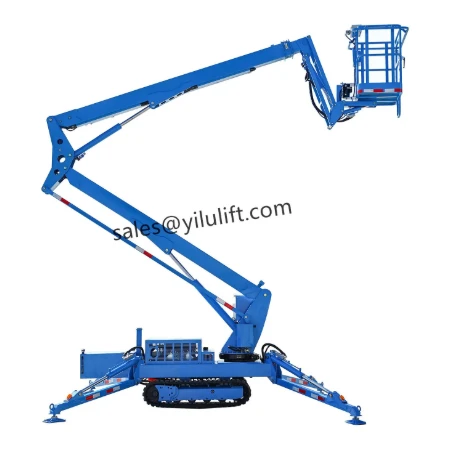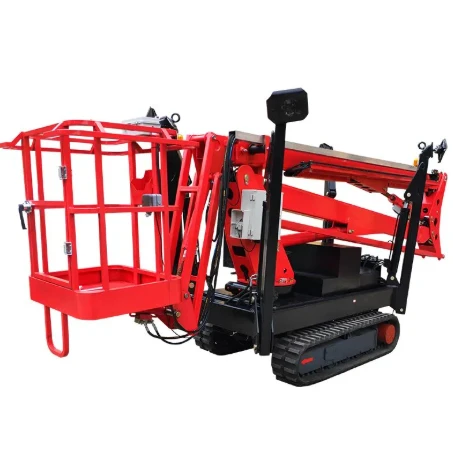How to Safely Park a Boom Lift on Uneven Ground
How to Safely Park a Boom Lift on Uneven Ground
How to Safely Park a Boom Lift on Uneven Ground
Parking a boom lift on uneven ground isn’t just hitting the brakes. It’s a big deal for keeping people safe and the machine in good shape. Many job sites have rough terrain—think construction zones or outdoor maintenance spots. Mess it up, and things can go wrong fast. That’s why knowing the risks and steps matters so much. In this post, we’ll cover the key points, using real-world tips to avoid trouble. Whether you’re running the lift or managing a fleet, these ideas can help.

Why Is Parking on Uneven Ground Risky?
Rough ground makes things tricky since boom lifts are tall and top-heavy. They’re not like trucks that stick close to the road. A small hill or soft spot can turn a quick stop into a problem. Let’s look at the main issues.
Tip-Over Hazards from High Center of Gravity
Boom lifts sit high, especially with the arm out. That high balance point makes them easy to tip if the ground’s not flat. Picture parking on a slope—one wrong move, and it’s falling. It happens more than you’d think on sites with loose dirt or hidden dips.
Not every bumpy spot is a disaster. But skipping a check? That’s asking for trouble. Operators share stories of close calls where a quick look saved the day.
Stability Issues on Slopes
Slopes mess with balance fast. Even a gentle rise shifts weight unevenly across wheels or tracks. Rain or mud makes it worse, turning solid ground into a slick mess. Staying steady isn’t just about not moving. It’s about the machine not rocking or sliding unexpectedly.
Wind plays a part too. On a hill, a gust hits harder against that tall frame. Everything’s connected.
Risk of Equipment Damage and Operator Harm
Beyond tipping, there’s wear and tear. Parking wrong stresses parts, pipes, and tires. Over time, that means costly fixes. Worse, if something breaks, the operator could get hurt—falls, crushes, you name it. Safety data shows these incidents often tie to bad parking choices on rough ground.
What Preparations Should You Make Before Parking?
Before you stop, some early steps set you up right. It’s like checking your car before a trip—do the basics to avoid trouble. Skipping this can lead to regrets. Here’s what to focus on.
Thorough Ground Check
Start by eyeing the area. Walk it if you can. Look for rocks, holes, or soft patches that might sink under weight. Use a level or phone app to check the slope. More than a few degrees? Pick a new spot.
Pre-Operation Machine Check
Give the boom lift a fast look. Check tires or tracks for wear, pipes for leaks, and brakes for grip. Make sure supports extend smoothly. If something’s off, fix it before moving.
This isn’t extra work. It’s your safety net. A bad part on rough ground makes problems bigger.
Operator Training Needs
Operators need proper lessons—not just basics, but how to handle terrain. Certifications teach reading ground and reacting. Refreshers keep skills sharp.
What Safety Features Should You Pick?
With the ground checked, rely on the machine’s safety gear. Not all boom lifts are equal—some handle rough terrain better. Choosing the right features makes parking less chancy. Let’s see what stands out.
Tilt Sensors and Alarms
These gadgets beep if the lean gets too steep. They stop work if needed, preventing tips. Look for adjustable ones to match your site.
Self-Leveling Supports
Outriggers spread the load, and self-leveling ones adjust automatically. They keep the base steady on dips or hills.
Auto Braking Systems
Auto brakes lock when you stop, holding position without fuss. Great for hills where rolling’s a risk.
How to Position the Boom Lift Right?
Now the hands-on part: setting the lift in place. Go step by step, and uneven ground won’t faze you. This builds on your check, turning plans into action. Take it slow—rushing leads to mistakes.

Leveling on Slopes
Lower the boom fully first. Extend outriggers to level the chassis. Use pads if gaps show.
Outrigger Setup Tips
Deploy all outriggers evenly. Pad them on soft ground to avoid sinking. Retract the boom before final tweaks.
Boom Retraction and Alignment
Pull the arm in completely. Line up wheels or tracks straight. Double-check level.
What Steps Come After Parking?
Parking isn’t done when the engine stops. Final steps lock it in safe. These wrap up the job, ensuring nothing shifts overnight. Miss them, and morning brings surprises.
Secure Brakes and Wheel Blocks
Set the parking brake. Chock wheels on slopes—front and back.
Extra guard against rolls. Cheap safety.
Full Power Shutdown
Kill the engine or battery. Remove keys. Drain hydraulics if the manual says so.
Securing the Area
Cordon off with cones or tape. Post signs. Lock controls.
Why Pick YILU LIFT for Uneven Terrain?
Looking for gear that handles rough ground well? Check out YILU LIFT. This Chinese maker focuses on work tools like aerial platforms, blending low cost with solid build. Their boom lifts stand out for business buyers abroad, with CE and ISO certifications. They use imported parts for trust without the high price. Here’s why they fit bumpy terrain needs.
YILU LIFT designs for real jobs—tree work, construction, or farms. Their products cut costs by two or three times compared to Western options, yet keep quality. Smart for businesses wanting solid tools.
Towable Boom Lift with Torsion Axle Stability
The 10-24m Towable Boom Lift shines with its torsion axle. It keeps wheels grounded on bumps, unlike stiff axles that lift off. Reaches 24m working height, with 220-300kg loads.
Tow it behind a vehicle at 40km/h max. Safety includes auto brakes that lock if the tow stops suddenly. Tilt control via touch screen lets you set a max angle—it halts if exceeded. Great for mobile jobs on rough land. Self-leveling pads add grip when parked.
Crawler Boom Lift for Tough Ground
The 10-22m Crawler Boom Lift uses tracks to move over rough stuff. Hits 22m working height, 200kg standard load (up to 300kg optional).
Moves in tight spots and handles slopes well. Self-leveling soles keep it balanced. Safety includes explosion-proof valves and emergency drops. Ideal for farms or build sites where wheels sink. Tracks give an all-terrain edge.
Smart Safety Features like Tilt Angle Control
Across models, tilt sensors and alarms stop over-tilts. Waterproof boxes protect in rain. Anti-drop devices and safety harnesses cover operators. These are built in, not extras. For parking on uneven ground, they make setup safe and quick.
YILU LIFT offers various power options—diesel, gas, electric, hybrids. Contact us for details. For exporting industrial gear, their B2B setup makes ordering easy.
Safe parking comes down to prep, care, and the right machine. Uneven ground doesn’t have to stop you. Follow these steps, and work stays smooth.
FAQs
Q1: What slope is too steep for parking a boom lift?
A: Most manuals say under 5 degrees is safe. Check your model’s specs. Use a level to confirm, and always deploy outriggers for extra steadiness.
Q2: How often should I check my boom lift before parking on uneven ground?
A: Look it over every time—tires, pipes, brakes. Full maintenance? Follow the schedule, usually monthly or after heavy use, to catch issues early.
Q3: Can YILU LIFT boom lifts handle wet or muddy terrain?
A: Yes, especially crawler models with tracks for grip. Towable ones have torsion axles to stay grounded. Waterproof features help, but always check soil first to avoid sinking.




